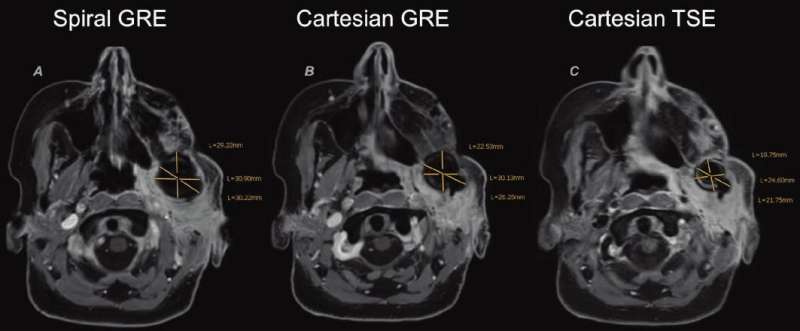Examination included spiral gradient recalled echo (GRE) (A), Cartesian GRE (B), and Cartesian turbo spin echo (TSE) (C) sequences. Artifact is present in left paranasal region due to dental material. Artifact measures (mean of three manual measurements) 30.1 mm on spiral GRE, 26.3 mm on Cartesian GRE, and 22 mm on Cartesian TSE. Credit: American Roentgen Ray Society (ARRS), American Journal of Roentgenology
According to an open-access Editor's Choice article in the American Journal of Roentgenology (AJR), a 3D spiral gradient recalled echo (GRE) sequence could help conquer certain challenges of conventional Cartesian sequences for head and neck MRI.
"3D spiral GRE improves subjective image quality and contrast-to-noise ratio (CNR) of head and neck MRI with shorter scan time versus Cartesian sequences, though exhibits larger dental material artifact," wrote corresponding author Sabine Sartoretti-Schefer from the Institute of Radiology at Kantonsspital Winterthur in Switzerland.
From August 2020 to May 2021, Sartoretti-Schefer and team prospectively studied patients referred for contrast-enhanced head and neck MRI. Patients underwent 1.5-T MRI (Ingenia; Philips Healthcare, Best, the Netherlands), including contrast-enhanced [Gadovist (Gadobutrol) 1.0 mmol/mL, Bayer HealthCare Pharmaceuticals, 0.1 mL/kg body weight] spiral GRE (2:28 min), Cartesian GRE (4:27 min), and Cartesian turbo spin echo (TSE) (3:41 min) sequences, acquired in rotating order to mitigate bias.
Among 31 patients (13 male, 18 female; mean age, 63.8 years) who underwent head and neck MRI, spiral GRE, compared with Cartesian GRE and Cartesian TSE, achieved improved image quality for numerous subjective measures for three independent readers and improved CNR, with 33.0%–44.6% reduced scan time. However, maximal extent of dental material artifact was greatest for spiral GRE.
Reiterating that the 3D spiral GRE sequence "exhibited larger susceptibility artifacts in association with dental material," the authors of this AJR article expressed special consideration for patients with dental implants or fillings.
More information: Elisabeth Sartoretti et al, Contrast-Enhanced T1-Weighted Head and Neck MRI: Prospective Intraindividual Image Quality Comparison of Spiral GRE, Cartesian GRE, and Cartesian TSE Sequences, American Journal of Roentgenology (2021). DOI: 10.2214/AJR.21.26413
Journal information: American Journal of Roentgenology
Provided by American Roentgen Ray Society























